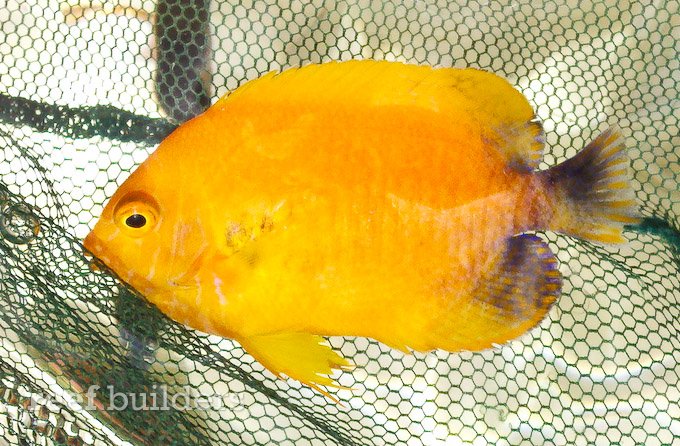This odd-colored Potter’s Angelfish, Centropyge potteri, was recently captured by Pacific Tropics in Hawaii. The Potters Angelfish is one of the Centropyge species which can show a great deal of variability in it’s color pattern, and Dave Kelly was lucky enough to spot and capture the xanthic potter’s angelfish at a depth of eighty feet. However there are many more unusual color forms of the Potter’s angelfish and other Centropyge species.



We’ve also previously reported on how one particular dark potter’s angelfish had developed a kind of darkish suntan after living in the shine of multiple thousand watt metal halide lamps. At least we believe the darkness to be attributed to the enormous amount of UV light that 1000 watt metal halides can give off. There also exists an axanthic form of Centropyge potteri, the blue potter’s angelfish, which exhibits almost no yellow coloration, leaving it with beautiful blue bars on a black base coloration.
Pacific Tropics is no stranger to catching the rare and the unusual as we’ll remind you that this is the Hawaiian collection outfit which also caught the rare Hybrid potter’s angelfish. The specific type of color aberration that this mostly yellow potter’s

angelfish represents can be endlessly debated but in our eyes, this specimen most closely resembles a xanthic color aberration. A similar color aberration in Centropyge might be the mostly yellow bicolor angelfish or the other odd-colored Centropyge bicolor that was caught in Papua New Guinea.
Unfortunately, it is unclear what causes these color changes in the wild-caught aberrant Centropyge as many, if not most, specimens end up reverting to a mostly normal coloration after a few weeks to a few months in captivity. the fact that the xnthic potters still has the black coloration but it is restricted to a portion of it’s caudal and soft anal fin gives us hope that this one could be a real freak.
We’re told that the xanthic potter’s angelfish is still up for grabs, let’s hope it stays stateside so we can have a chance at tracking how it’s color is retained in captivity. Huge thanks to William Crook for sharing the unique image fo the xanthic potter’s angelfish.




